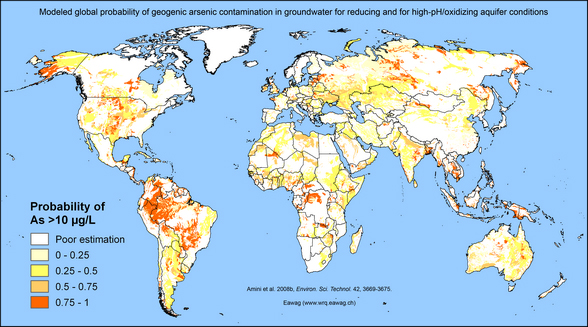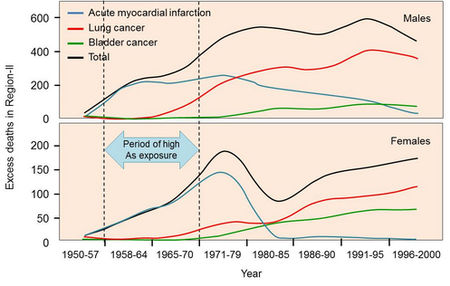Difference between revisions of "Geogenic contamination - Arsenic"
m (Protected "Geogenic contamination - Arsenic" ([Edit=Allow only administrators] (indefinite) [Move=Allow only administrators] (indefinite))) |
m (Protected "Geogenic contamination - Arsenic" ([Edit=Allow only administrators] (indefinite) [Move=Allow only administrators] (indefinite))) |
||
| Line 1: | Line 1: | ||
| + | ''NOTE: Modified article from the Geogenic Contamination Handbook'' | ||
== Occurrence == | == Occurrence == | ||
| − | [[File:Figure 2.2.jpg|600px|thumb|right| Fig. 2.2 Modelled global probability of elevated geogenic arsenic concentrations in groundwater (Amini et al., 2008a)]] Arsenic in drinking water is a global threat to health, potentially affecting about 140 million people in at least 70 countries worldwide (Ravenscroft et al., 2009). It is considered by some researchers to have more serious health effects than any other environmental contaminant (Smith and Steinmaus, 2009). | + | [[File:Figure 2.2.jpg|600px|thumb|right| Fig. 2.2 Modelled global probability of elevated geogenic arsenic concentrations in groundwater ''(Terms of use: Cite original source: Amini et al., 2008a)'']] Arsenic in drinking water is a global threat to health, potentially affecting about 140 million people in at least 70 countries worldwide (Ravenscroft et al., 2009). It is considered by some researchers to have more serious health effects than any other environmental contaminant (Smith and Steinmaus, 2009). |
| − | + | Under most geochemical conditions, arsenic in aquifers remains tightly bound to the sediments, and dissolved concentrations in the groundwater remain low. However, elevated concentrations of arsenic in groundwater can be found even when solid-phase concentrations in the sediments are unremarkable. (It is the 55th most abundant element in the Earth’s crust with an average content of 1.8 mg/kg). Such sediments are typically young and contain organic carbon that can be consumed by microbes. Microbes use oxygen or other oxidants present and create chemically reducing conditions in which reduced species, such as arsenic (arsenite, As(OH)3), iron (Fe(II)) and manganese (Mn(II)) predominate. Groundwater in low-permeable host rocks/sediments with chemically oxidising conditions, high pH and generally arid conditions may also be contaminated, though to a lesser degree (Smedley and Kinniburgh, 2002). Figure 2.2 shows the modelled global probability of the occurrence of geogenic arsenic contamination in groundwater for both of these conditions combined. Geothermal contributions and sulphide oxidation from sulphide minerals in host rocks can also lead to elevated arsenic concentrations in groundwater, but these conditions tend to be more localised and have not been included in the model. | |
| Line 11: | Line 12: | ||
== Health effects == | == Health effects == | ||
| − | [[File:Figure 2.3.jpg|thumb| | + | [[File:Figure 2.3.jpg|thumb|right|450px|Fig. 2.3 Skin lesions (keratosis, melanosis) indicating arsenic poisoning ''(Terms of use - Cite original source from Handbook)'']][[File:Figure 2.4.jpg|thumb|right|450px|Fig. 2.4 Latency of cancer and heart disease in northern Chile. Drinking water contained approximately 800 µg/L arsenic from 1958–1971, after which an arsenic removal plant greatly reduced exposure. ''(Terms of use - Cite: Redrawn by Ravenscroft et al. (2009) after Yuan et al. (2007))'' ]]Arsenic causes a wide range of adverse health effects. The acute toxicity of As(III) is somewhat greater than that of As(V), but because As(V) is reduced to As(III) in the body, the two species can be considered equally toxic. |
The first obvious symptoms are often skin lesions (keratosis, melanosis; Fig. 2.3), but other effects can include weakness, diarrhoea, bronchitis, vascular disease and diabetes mellitus (UNICEF/Chinese Ministry of Health, 2004). | The first obvious symptoms are often skin lesions (keratosis, melanosis; Fig. 2.3), but other effects can include weakness, diarrhoea, bronchitis, vascular disease and diabetes mellitus (UNICEF/Chinese Ministry of Health, 2004). | ||
| Line 18: | Line 19: | ||
Because of the ongoing uncertainty about low-level effects and the difficulties involved in measuring arsenic concentrations below 10 µg/L or in reducing arsenic concentrations to this level, the WHO has set 10 µg/L as a provisional guideline value (WHO, 2011). Many countries have a less strict drinking-water standard of 50 µg/L. The disease burden at these levels can be considerable; Argos et al. (2010) found all-cause mortality levels to be 34% higher in a population exposed to 0.01–50 µg/L arsenic, compared to a control group with <10 µg/L exposure. Those exposed to 150 µg/L or more showed 68% higher all-cause mortality. | Because of the ongoing uncertainty about low-level effects and the difficulties involved in measuring arsenic concentrations below 10 µg/L or in reducing arsenic concentrations to this level, the WHO has set 10 µg/L as a provisional guideline value (WHO, 2011). Many countries have a less strict drinking-water standard of 50 µg/L. The disease burden at these levels can be considerable; Argos et al. (2010) found all-cause mortality levels to be 34% higher in a population exposed to 0.01–50 µg/L arsenic, compared to a control group with <10 µg/L exposure. Those exposed to 150 µg/L or more showed 68% higher all-cause mortality. | ||
There is no effective medical treatment for chronic arsenicosis, except for switching to an arsenic-free drinking-water source. However, palliative care such as application of ointments to cracked skin lesions can ease suffering. Chelation therapy is effective for short-term, acute poisoning, but not for long-term exposure. | There is no effective medical treatment for chronic arsenicosis, except for switching to an arsenic-free drinking-water source. However, palliative care such as application of ointments to cracked skin lesions can ease suffering. Chelation therapy is effective for short-term, acute poisoning, but not for long-term exposure. | ||
| + | |||
| + | ==References== | ||
| + | For references, please visit the page [[References - Geogenic Contamination Handbook]]. | ||
| + | |||
| + | ==Related articles on GAP Wiki== | ||
| + | *[[ Geogenic contamination | Geogenic contamination ]] | ||
| + | *[[Geogenic contamination - Fluoride|Geogenic contamination - Fluoride]] | ||
| + | *[[The development of probability maps|The development of probability maps]] | ||
Latest revision as of 13:01, 10 May 2018
NOTE: Modified article from the Geogenic Contamination Handbook
Occurrence
Under most geochemical conditions, arsenic in aquifers remains tightly bound to the sediments, and dissolved concentrations in the groundwater remain low. However, elevated concentrations of arsenic in groundwater can be found even when solid-phase concentrations in the sediments are unremarkable. (It is the 55th most abundant element in the Earth’s crust with an average content of 1.8 mg/kg). Such sediments are typically young and contain organic carbon that can be consumed by microbes. Microbes use oxygen or other oxidants present and create chemically reducing conditions in which reduced species, such as arsenic (arsenite, As(OH)3), iron (Fe(II)) and manganese (Mn(II)) predominate. Groundwater in low-permeable host rocks/sediments with chemically oxidising conditions, high pH and generally arid conditions may also be contaminated, though to a lesser degree (Smedley and Kinniburgh, 2002). Figure 2.2 shows the modelled global probability of the occurrence of geogenic arsenic contamination in groundwater for both of these conditions combined. Geothermal contributions and sulphide oxidation from sulphide minerals in host rocks can also lead to elevated arsenic concentrations in groundwater, but these conditions tend to be more localised and have not been included in the model.
Health effects
The first obvious symptoms are often skin lesions (keratosis, melanosis; Fig. 2.3), but other effects can include weakness, diarrhoea, bronchitis, vascular disease and diabetes mellitus (UNICEF/Chinese Ministry of Health, 2004).
The main health concerns, however, are cancers of the skin or internal organs. In particular, arsenic-related lung and bladder cancers can cause heavy mortality (Argos et al., 2010; Sohel et al., 2009). More recently, arsenic exposure has been linked to cardiac effects such as myocardial infarction (heart attacks) (Yuan et al., 2007). Cardiac risks are elevated within short exposure periods, while cancers can take decades to develop, even long after arsenic exposure has stopped (Fig. 2.4). In addition, arsenic is linked with a range of impacts on children, including reduced birth weight, infant mortality and impaired cognitive development (Smith and Steinmaus, 2009).
Because of the ongoing uncertainty about low-level effects and the difficulties involved in measuring arsenic concentrations below 10 µg/L or in reducing arsenic concentrations to this level, the WHO has set 10 µg/L as a provisional guideline value (WHO, 2011). Many countries have a less strict drinking-water standard of 50 µg/L. The disease burden at these levels can be considerable; Argos et al. (2010) found all-cause mortality levels to be 34% higher in a population exposed to 0.01–50 µg/L arsenic, compared to a control group with <10 µg/L exposure. Those exposed to 150 µg/L or more showed 68% higher all-cause mortality. There is no effective medical treatment for chronic arsenicosis, except for switching to an arsenic-free drinking-water source. However, palliative care such as application of ointments to cracked skin lesions can ease suffering. Chelation therapy is effective for short-term, acute poisoning, but not for long-term exposure.
References
For references, please visit the page References - Geogenic Contamination Handbook.


